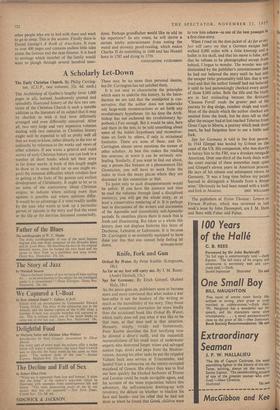Let-Down A Scholarly
The Early Christian Church. By Philip Carring- ton. (C.U.P., two volumes, 52s. 6d. each.)
THE Archbishop of Quebec's lengthy (over 1,000 pages in all), learned, handsomely printed and splendidly illustrated history of the first two cen- turies of the Christian Church is such a notable addition to the literature of its subject that it may be churlish to wish it had been differently arranged and even differently conceived. After all, two very large and very expensive volumes dealing with two centuries in Christian history might well be expected to tell us pretty well all that we want to know, either directly in the text or indirectly by reference to the works and views of other scholars. If one wants a general and rapid survey of early Christian history one can look to a number of short books which tell their story in far fewer words. A book of this length ought to show us in some detail (or so one might ex- pect) the immense difficulties which scholars face in getting at the facts of the genesis and earliest development of Christianity. It ought to let us in on some of the controversy about Christian origins, to indicate where nothing more than opinion is possible and where opinions differ. It would be an advantage if it were readily usable by the man who wants to look up a particular person or episode in the story and find the event or the life or the doctrine discussed connectedly. These may be no more than personal desires, but Dr. Carrington has not satisfied them.
It is not easy to characterise the principles which seem to underlie this history. In the Intro- duction we are told that the standpoint is con- servative, that the author does not undertake any large-scale reconstructions or set forth any revolutionary hypotheses. (In his time the Arch- bishop has not eschewed the revolutionary hy- pothesis.) Fair enough. But it would be nice, here and there in the text, to be told something about some of the bolder .hypotheses and reconstruc- tions set forth by others, if only in occasional footnotes. There are none of these, and Dr. Carrington almost never mentions the names of other scholars. At best this makes the reading less onerous; at worst it can be seriously mis- leading. Similarly, if you want to find out about, say, a person like Irenmus or a phenomenon like Gnosticism, you will have to work from the index to trace the many places where they are discussed in this connection or that.
To point only to such disappointments would be unfair. If you have the patience and time to read the volumes through (and a disciplined memory), you will get the whole story, or at least a conservative rendering of it. It is perhaps best in discussions of the writers and documents of the Apostolic and immediately sub-Apostolic periods. In countless places there is much that is fresh and illuminating. But taken as a whole this history does not displace histories like those of Duchesne, Lebreton or Leitzmann. It is because Dr. Carrington is so eminently equipped to have done just this that one cannot help feeling let










































































 Previous page
Previous page